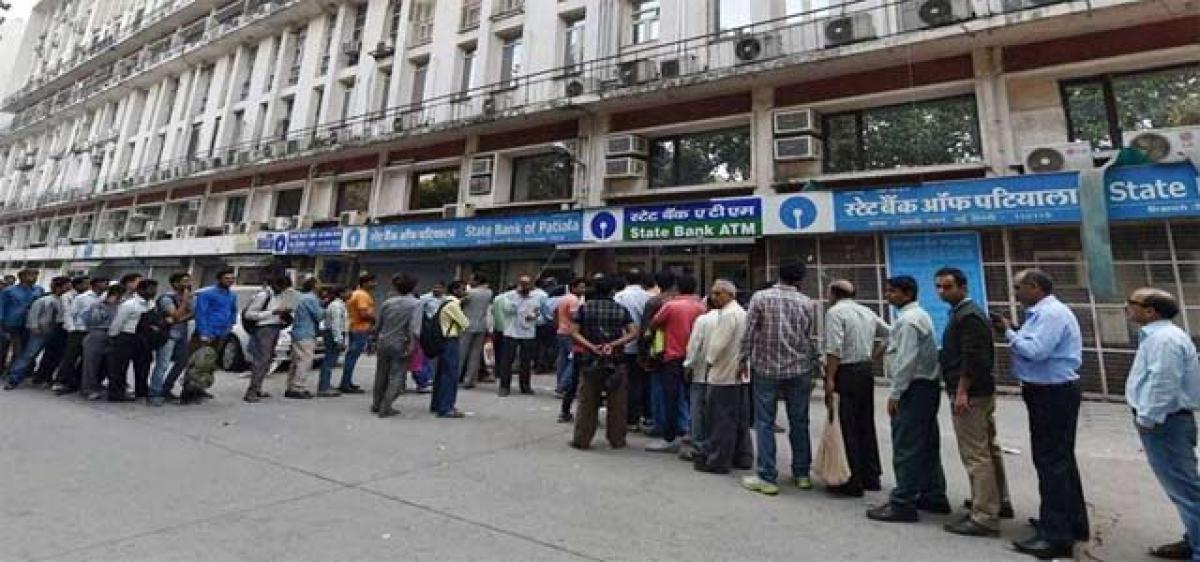Live
- ICC’s arrest warrants call for accountability
- Author’s intellection key to autobiography
- India has firepower to win series down under
- MyVoice: Views of our readers 24th November 2024
- Meet four trailblazing women striving tirelessly to protect the planet
- Konkona Sen Sharma goes international, to star opposite Javier Bardem’s brother Carlos in ‘Mis(s)chief’
- Prime Minister Narendra Modi to Visit Visakhapatnam on November 29
- People in my life inspire my fictional characters: Sugandha Pallan
- Japanese girl group, XG to make Coachella debut in April next year
- Are strict laws needed to ensure MLAs attend Assembly sessions?
Just In

The D-Day arrived on Friday, but there seems to be no end in sight to the ordeal and hardships that people have been going through for the past 53 days to lay their hands on a few valid currency notes.
The D-Day arrived on Friday, but there seems to be no end in sight to the ordeal and hardships that people have been going through for the past 53 days to lay their hands on a few valid currency notes.
On November 8, Prime Minister Narendra Modi took the nation by surprise when he announced his government’s decision to abolish high value currency notes of Rs 500 and 1,000.
This unexpected announcement delegalised a massive 86 per cent, or Rs 14.95 lakh crore, of the currency in circulation in a country which largely depends on cash for daily sustenance.
It sent seismic waves across India and forced people to pour onto streets to line up before ATMs even as Modi kept stoutly defending his decision, saying it would curb black money, eliminate counterfeit currency and choke terror funding.
He also advised people to deposit all the banned notes in banks by December 30, the deadline set by the RBI.
Even as reports flew thick and fast about how Modi did not even take Finance Minister Arun Jaitley and other leaders into confidence before going for such a major decision, the country plunged into an acute cash chaos as RBI failed to infuse adequate into the system.
The apex bank’s ill-advised decision to release new Rs 2,000 note further aggravated the situation thanks to the shortage of lower denomination notes. A majority of 2.2 lakh ATMs went out of service and banks started rationing currency.
Sensing discontent among people, Modi made an impassionate plea to the nation to give him 50 days and claimed that India would be a transformed nation thereafter.
Interestingly, both the 50-day deadline set by Modi and the last day for depositing old notes in banks ended on Friday.
Though RBI gave time till March 31, 2017 to deposit old notes at its branches, most of the delegalised notes have already knocked on the doors of banks, putting question marks over the government’s claims that the move will weed out illicit wealth and help it coffers grow.
Hoarders of ill-gotten wealth, going by reports, found myriad ways to convert their stash in old denominations into sparkling new currency.
And it will take several years for the I-T department to rummage through the mountain of data with banks to nail those who escaped from the tax net.
The other tall objectives of the move – eradicating duplicate notes and plugging financial channels of terrorists – are also likely to meet the same fate.
But the Modi government cleverly tried to change the narrative by bringing cashless transactions into focus. But this course correction may not cut much ice with people.
Due to the note ban, businesses – small and big – have suffered; traders are at the receiving end and there is no segment which escaped unscathed from this turmoil.
Economy is expected to lose steam and cash crunch is still haunting the nation. The trillion dollar question that Modi government will have to answer is why it forcibly imposed the note ban on the country when it knew it could not achieve the stated goals.

© 2024 Hyderabad Media House Limited/The Hans India. All rights reserved. Powered by hocalwire.com







